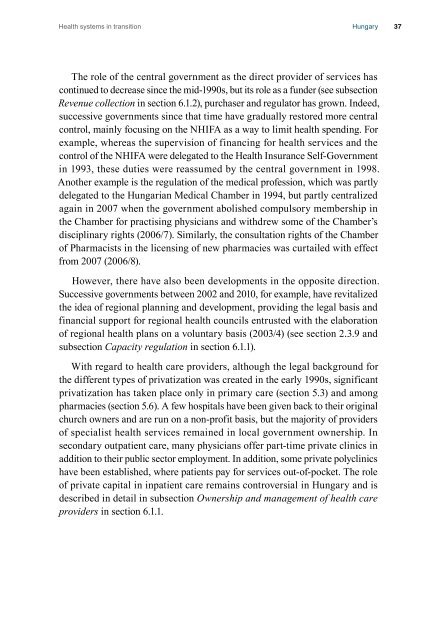Health Systems in Transition - Hungary - World Health Organization ...
Health Systems in Transition - Hungary - World Health Organization ...
Health Systems in Transition - Hungary - World Health Organization ...
Create successful ePaper yourself
Turn your PDF publications into a flip-book with our unique Google optimized e-Paper software.
<strong>Health</strong> systems <strong>in</strong> transition <strong>Hungary</strong> 37<br />
The role of the central government as the direct provider of services has<br />
cont<strong>in</strong>ued to decrease s<strong>in</strong>ce the mid-1990s, but its role as a funder (see subsection<br />
Revenue collection <strong>in</strong> section 6.1.2), purchaser and regulator has grown. Indeed,<br />
successive governments s<strong>in</strong>ce that time have gradually restored more central<br />
control, ma<strong>in</strong>ly focus<strong>in</strong>g on the NHIFA as a way to limit health spend<strong>in</strong>g. For<br />
example, whereas the supervision of f<strong>in</strong>anc<strong>in</strong>g for health services and the<br />
control of the NHIFA were delegated to the <strong>Health</strong> Insurance Self-Government<br />
<strong>in</strong> 1993, these duties were reassumed by the central government <strong>in</strong> 1998.<br />
Another example is the regulation of the medical profession, which was partly<br />
delegated to the Hungarian Medical Chamber <strong>in</strong> 1994, but partly centralized<br />
aga<strong>in</strong> <strong>in</strong> 2007 when the government abolished compulsory membership <strong>in</strong><br />
the Chamber for practis<strong>in</strong>g physicians and withdrew some of the Chamber’s<br />
discipl<strong>in</strong>ary rights (2006/7). Similarly, the consultation rights of the Chamber<br />
of Pharmacists <strong>in</strong> the licens<strong>in</strong>g of new pharmacies was curtailed with effect<br />
from 2007 (2006/8).<br />
However, there have also been developments <strong>in</strong> the opposite direction.<br />
Successive governments between 2002 and 2010, for example, have revitalized<br />
the idea of regional plann<strong>in</strong>g and development, provid<strong>in</strong>g the legal basis and<br />
f<strong>in</strong>ancial support for regional health councils entrusted with the elaboration<br />
of regional health plans on a voluntary basis (2003/4) (see section 2.3.9 and<br />
subsection Capacity regulation <strong>in</strong> section 6.1.1).<br />
With regard to health care providers, although the legal background for<br />
the different types of privatization was created <strong>in</strong> the early 1990s, significant<br />
privatization has taken place only <strong>in</strong> primary care (section 5.3) and among<br />
pharmacies (section 5.6). A few hospitals have been given back to their orig<strong>in</strong>al<br />
church owners and are run on a non-profit basis, but the majority of providers<br />
of specialist health services rema<strong>in</strong>ed <strong>in</strong> local government ownership. In<br />
secondary outpatient care, many physicians offer part-time private cl<strong>in</strong>ics <strong>in</strong><br />
addition to their public sector employment. In addition, some private polycl<strong>in</strong>ics<br />
have been established, where patients pay for services out-of-pocket. The role<br />
of private capital <strong>in</strong> <strong>in</strong>patient care rema<strong>in</strong>s controversial <strong>in</strong> <strong>Hungary</strong> and is<br />
described <strong>in</strong> detail <strong>in</strong> subsection Ownership and management of health care<br />
providers <strong>in</strong> section 6.1.1.
















